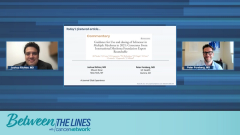
Looking Forward: Advice for Clinicians and Discussing Unmet Needs in the R/R MM Landscape
Dr. Joshua Richter and Dr. Peter Forsberg close their discission with thoughtful advice for clinicians regarding the current and future treatment of patients with R/R MM.
Episodes in this series

Dr. Peter Forsberg: I think being thoughtful, being aware of dosing structures, proactive with supportive measures, I think if there's any guidance I can give to myeloma providers as they're deciding what therapies to use and how to use selinexor, it's that. And I do think that this review that we started from is a good tool, if you're wondering where to begin with, drawing up that article, it's got really down-to-earth evidence, explanations, and I guess could say really accessible guidance for how to maneuver through using selinexor.
Dr. Joshua Richter: No, but I think that's because you and I used to struggle all the time, having that 10-minute conversation of what's going to be the partner – what's the best partner, what's the best dose in prophylaxis can really change how patients experience and can optimally benefit from the drug. So I think having those conversations are really important.
Dr. Peter Forsberg: No, I agree. I think that's what we're here for, is to be a resource. And I think that can come in a diverse number of ways. So absolutely. I think that – tap into all those resources that might be available to you, whether that's through the folks at Carrier Pharm or local experts. I guess I know we all have different thoughts, but I know probably more similar than different in terms of unmet needs for the treatment of relapsed or refractory myeloma as maybe a last note to discuss before we go out?
Dr. Joshua Richter: Yeah, obviously, the big probably umbrella unmet need is we don't have a cure, and we need 100% a cure for 100% of patients. I know that's the easy answer. I think, as you talked about, our toolbox is getting deeper, and when you come become refractory to more and more of these agents, it's what do you do next? When you're refractory to CD38, what's next? When you're refractory to CAR-T, what's next? So I think it's really about right now being refractory to – just penta-refractory plus being refractory to BCMA agents. And there's some other nice therapies that are coming along the way targeting FCRH5 and GPRC5D, but I know we're already on brand, but there's some data already from patients on STORM back in 2019 who were post CAR-T who responded to selinexor, so kinda make it full circle, I think that's helping to fulfill that need, but obviously, we'll always need more. How about you? What are some of the big hits that we still need to solve?
Dr. Peter Forsberg: Yeah, no, I certainly think those are all key. We keep moving the goal posts each time we – it wasn't that long ago that, whatever, triple-class refractory or people who – then penta and now post-penta plus BCMA is really our – I certainly think we also need better data about when we can peel back, when we can scale back, how we can get some of these steroids, other things out of the mix, give patients breaks. Certainly, there's a lot of great work that we can hopefully do to build on this really robust foundation of myeloma therapies. We certainly know we're not where we want to be, we need to cross that cure threshold with much more consistency. I do think that we just need to keep refining beyond that, in terms of how we best use the tools that we do have. So I guess, I think that's it for me. Anything else from you, Josh, as we wrap this robust conversation of selinexor data up?
Dr. Joshua Richter: No. It's been a pleasure working with you, and thank you Cancer Network.
Newsletter
Stay up to date on recent advances in the multidisciplinary approach to cancer.



















































































